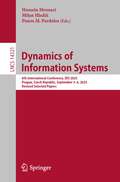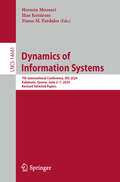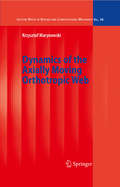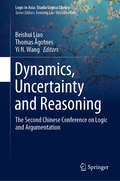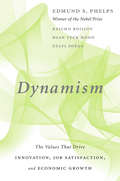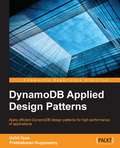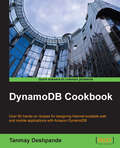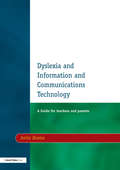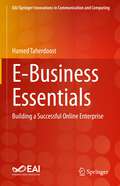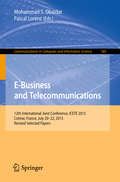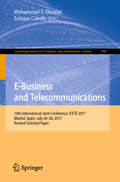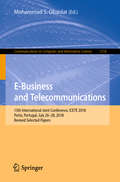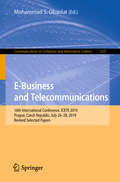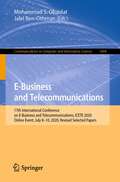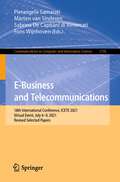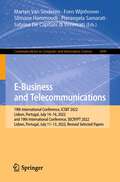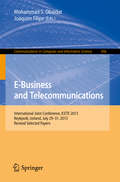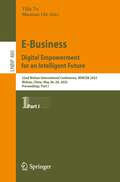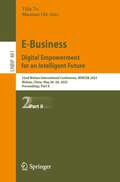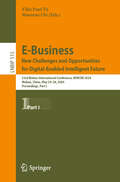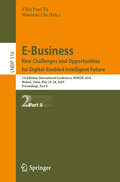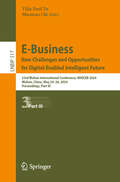- Table View
- List View
Dynamics of Information Systems: 6th International Conference, DIS 2023, Prague, Czech Republic, September 3–6, 2023, Revised Selected Papers (Lecture Notes in Computer Science #14321)
by Panos M. Pardalos Hossein Moosaei Milan HladíkThis book constitutes the proceedings of the 6th International Conference on Dynamics of Information Systems, DIS 2023, which took place in Prague, Czech Republic, in September 2023. The 18 full papers included in the book were carefully reviewed and selected from 43 submissions. They deal with topics ranging from theoretical, algorithmic, and practical perspectives in information systems, to offering readers valuable information, theories and techniques.
Dynamics of Information Systems: 7th International Conference, DIS 2024, Kalamata, Greece, June 2–7, 2024, Revised Selected Papers (Lecture Notes in Computer Science #14661)
by Panos M. Pardalos Ilias Kotsireas Hossein MoosaeiThis post conference LNCS volume constitutes the proceedings of the 7th International Conference on Dynamics of Information Systems, DIS 2024, in Kalamata, Greece, took place in June 2024. The 19 full papers together included in this volume were carefully reviewed and selected from 40 submissions. The conference presents topics such as information systems, optimization, operations research, machine learning, and artificial intelligence.
Dynamics of the Axially Moving Orthotropic Web
by Krzysztof MarynowskiA material continuum moving axially at high speed can be met in numerous different technical applications. These comprise band saws, web papers during manufacturing, processing and printing processes, textile bands during manufacturing and processing, pipes transporting fluids, transmission belts as well as flat objects moving at high speeds in space. In all these so varied technical applications, the maximum transport speed or the transportation speed is aimed at in order to increase efficiency and optimize investment and performance costs of sometimes very expensive and complex machines and installations. The dynamic behavior of axially moving systems very often hinders from reaching these aims. The book is devoted to dynamics of axially moving material objects of low flexural stiffness that are referred to as webs. Webs are moving at high speed, for example, in paper production the paper webs are transported with longitudinal speeds of up to 3000 m/min. Above the critical speed one can expect various dynamical instabilities mainly of divergent and flutter type. The up-to-date state of investigations conducted in the field of the axially moving system dynamics is presented in the beginning of the book. Special attention is paid on nonlinear dynamic investigations of translating systems. In the next chapters various mathematical models that can be employed in dynamic investigations of such objects and the results of analysis of the dynamic behavior of the axially moving orthotropic material web are presented. To make tracing the dynamic considerations easier, a paper web is the main object of investigations in the book.
Dynamics, Uncertainty and Reasoning: The Second Chinese Conference on Logic and Argumentation (Logic in Asia: Studia Logica Library)
by Beishui Liao Thomas Ågotnes Yi N. WangThis volume collects selected papers presented at the Second Chinese Conference on Logic and Argumentation in 2018 held in Hangzhou, China. The papers presented reflect recent advances in logic and argumentation, as well as the connections between the two, and also include invited papers contributed by leading experts in these fields. The book covers a wide variety of topics related to dynamics, uncertainty and reasoning. It continues discussions on the interplay between logic and argumentation which has a long history from Aristotle’s ancient logic to very recent formal argumentation in AI.
Dynamische Disposition
by Timm GudehusDie dynamische Disposition ermöglicht marktgerechte Lieferzeiten und kostenoptimale Lieferfähigkeit, sie verhindert überhöhte oder unzureichende Bestände. In dem Buch werden Strategien, Algorithmen und Verfahren der dynamischen Auftrags-, Bestands- und Fertigungsdisposition allgemein verständlich beschrieben und anhand von Beispielen demonstriert. Mithilfe des Regelwerks kann die dynamische Disposition in allen Branchen organisiert und implementiert werden. Die erweiterte 3. Auflage zeigt Potenziale für Serviceverbesserung und Kosteneinsparung auf.
Dynamism: The Values That Drive Innovation, Job Satisfaction, and Economic Growth
by Edmund S. Phelps Gylfi Zoega Raicho Bojilov Hian Teck HoonNobel Laureate Edmund Phelps and an international group of economists argue that economic health depends on the widespread presence of certain values, in particular individualism and self-expression. Nobel Laureate Edmund Phelps has long argued that the high level of innovation in the lead nations of the West was never a result of scientific discoveries plus entrepreneurship, as Schumpeter thought. Rather, modern values—particularly the individualism, vitalism, and self-expression prevailing among the people—fueled the dynamism needed for widespread, indigenous innovation. Yet finding links between nations’ values and their dynamism was a daunting task. Now, in Dynamism, Phelps and a trio of coauthors take it on. Phelps, Raicho Bojilov, Hian Teck Hoon, and Gylfi Zoega find evidence that differences in nations’ values matter—and quite a lot. It is no accident that the most innovative countries in the West were rich in values fueling dynamism. Nor is it an accident that economic dynamism in the United States, Britain, and France has suffered as state-centered and communitarian values have moved to the fore. The authors lay out their argument in three parts. In the first two, they extract from productivity data time series on indigenous innovation, then test the thesis on the link between values and innovation to find which values are positively and which are negatively linked. In the third part, they consider the effects of robots on innovation and wages, arguing that, even though many workers may be replaced rather than helped by robots, the long-term effects may be better than we have feared. Itself a significant display of creativity and innovation, Dynamism will stand as a key statement of the cultural preconditions for a healthy society and rewarding work.
DynamoDB Applied Design Patterns
by Uchit Vyas Prabhakaran KuppusamyIf you are an intermediate to advanced DynamoDB developer looking to learn the best practices associated with efficient data modeling, this book is for you.
DynamoDB Cookbook
by Tanmay DeshpandeOver 90 hands-on recipes to design Internet scalable web and mobile applications with Amazon DynamoDB About This Book * Construct top-notch mobile and web applications with the Internet scalable NoSQL database and host it on cloud * Integrate your applications with other AWS services like AWS EMR, AWS S3, AWS Redshift, and AWS CloudSearch etc. in order to achieve a one-stop application stack * Step-by-step implementation guide that provides real-world use with hands-on recipes Who This Book Is For This book is intended for those who have a basic understanding of AWS services and want to take their knowledge to the next level by getting their hands dirty with coding recipes in DynamoDB. What You Will Learn * Design DynamoDB tables to achieve high read and write throughput * Discover best practices like caching, exponential back-offs and auto-retries, storing large items in AWS S3, storing compressed data etc. * Effectively use DynamoDB Local in order to make your development smooth and cost effective * Implement cost effective best practices to reduce the burden of DynamoDB charges * Create and maintain secondary indexes to support improved data access * Integrate various other AWS services like AWS EMR, AWS CloudSearch, AWS Pipeline etc. with DynamoDB In Detail AWS DynamoDB is an excellent example of a production-ready NoSQL database. In recent years, DynamoDB has been able to attract many customers because of its features like high-availability, reliability and infinite scalability. DynamoDB can be easily integrated with massive data crunching tools like Hadoop /EMR, which is an essential part of this data-driven world and hence it is widely accepted. The cost and time-efficient design makes DynamoDB stand out amongst its peers. The design of DynamoDB is so neat and clean that it has inspired many NoSQL databases to simply follow it. This book will get your hands on some engineering best practices DynamoDB engineers use, which can be used in your day-to-day life to build robust and scalable applications. You will start by operating with DynamoDB tables and learn to manipulate items and manage indexes. You will also discover how to easily integrate applications with other AWS services like EMR, S3, CloudSearch, RedShift etc. A couple of chapters talk in detail about how to use DynamoDB as a backend database and hosting it on AWS ElasticBean. This book will also focus on security measures of DynamoDB as well by providing techniques on data encryption, masking etc. By the end of the book you'll be adroit in designing web and mobile applications using DynamoDB and host it on cloud. Style and approach An easy-to-follow guide, full of real-world examples, which takes you through the world of DynamoDB following a step-by-step, problem-solution based approach.
Dyslexia and Information and Communications Technology: A Guide for Teachers and Parents
by Anita KeatesEffective use of ICT can enhance many dyslexic pupils' access to the curriculum, but it has to be used appropriately. This book will be useful to all teachers, teaching assistants, SENCOs and parents who are keen to have practical advice on how to help a child in this way. Full of strategies and suggestions that are based on the author's extensive classroom experience, this accessible book is suitable for the ICT novice and more advanced user alike. The book has been fully updated to guide the user through the maze of hardware and software currently available, identifying those most suitable for different Key Stages and curriculum subjects as well as providing ICT solutions to the problems of assessing and screening for dyslexia.
Démarrer Avec Android Studio
by Victor Thivillier Barbara HohenseeDémarrer avec Android studio Une introduction à Android studio Le livre donne un aperçu des nouvelles fonctionnalités et possibilités. Il commence avec l'installation et la configuration d'Android Studio. Vous prendrez connaissance du nouvel IDE et de son éditeur. Vous apprendrez à créer de nouveaux projets Android à partir de zéro, à importer sous Android Studio des projets de nature différente comme un ancien projet Eclipse ou des projets Android depuis GitHub. Le livre contient également une introduction au système de build Gradle, avec plusieurs exemples concrets. En outre, vous verrez la signature, la construction et l'exécution d'applications ainsi que leur préparation pour l'Android Market: - Captures d'écran - Signature avec l'Assistant de signature - Signature d'un apk de release en utilisant Gradle Création et exécution de projets de test dans Android Studio. Le livre contient également plusieurs exemples sur les dépendances et les bibliothèques (ActionBar Sherlock, publicité avec Admob, Google Play SDK, Api Google Maps v2) Mise en place d'un dépôt Maven local, construction de bibliothèques aar. Vous pourrez prendre connaissance des product flavors - Types de Build - Variantes de build, et apprendre à construire différents APK de partir du même projet (comprend un exemple avec 2 flavors). Développement de jeux avec AndEngine et libGDX Intégration des jeux JavaScript dans un projet Android Studio [LIME GameEngine] Développement pour Google TV Templates de code Android: - Que sont les templates de code Android - Où trouver les templates ADT (Outils de développement Android)- Création de templates de code personnalisés Le livre contient plusieurs exemples de projets complets et Android exécutables à télécharger (Code source).
E Governance Data Center, Data Warehousing and Data Mining: Vision to Realities
by Sonali Agarwal M. D. Tiwari Iti TiwariThis book attempts to disseminate information about several E Governance projects and possible Data Mining benefits which are the future of good governance in India.
E-Business Essentials: Building a Successful Online Enterprise (EAI/Springer Innovations in Communication and Computing)
by Hamed TaherdoostThis textbook presents comprehensive treatment of the e-business environment and the tools and strategies necessary for success in the digital realm. The author covers a wide range of e-business-related topics, such as e-environment, e-business security, billing and payment systems, supply chain management, digital marketing, customer relationship management, business intelligence, e-business adoption, change management, performance measurement, legal, and regulatory. The book focuses on the ethical and legal issues of e-business and offers practical advice for establishing and maintaining successful e-business operations. The book also discusses the challenges of keeping up with swiftly evolving technology and the ever-changing internet landscape, including online transactions, data security, and administration. The author seeks to advance e-business research and practice by providing a comprehensive and up-to-date overview of the field. The author includes case studies that span various industries and companies, from small startups to large corporations, providing readers with a diverse and practical perspective on e-business.
E-Business and Telecommunications
by Mohammad S. Obaidat Pascal LorenzThis bookconstitutes the refereed proceedings of the 12th International Joint Conferenceon E-Business and Telecommunications, ICETE 2015, held in Colmar, France, inJuly 2015. ICETE is a joint international conference integrating four majorareas of knowledge that are divided into six corresponding conferences:International Conference on Data Communication Networking, DCNET; InternationalConference on E-Business, ICE-B; International Conference on OpticalCommunication Systems, OPTICS; International Conference on Security andCryptography, SECRYPT; International Conference on Wireless InformationSystems, WINSYS; and International Conference on Signal Processing andMultimedia, SIGMAP. The 23 fullpapers presented together with an invited paper in this volume were carefully reviewed and selected from 218 submissions. Thepapers cover the following key areas of e-business and telecommunications: datacommunication networking; e-business; optical communication systems; securityand cryptography; signal processing and multimedia applications; wirelessinformation networks and systems.
E-Business and Telecommunications: 14th International Joint Conference, ICETE 2017, Madrid, Spain, July 24-26, 2017, Revised Selected Paper (Communications in Computer and Information Science #990)
by Mohammad S. Obaidat Enrique CabelloThis book constitutes the refereed proceedings of the 14th International Joint Conference on E-Business and Telecommunications, ICETE 2017, held in Madrid, Spain, in July 2017. ICETE is a joint international conference integrating four major areas of knowledge that are divided into six corresponding conferences: International Conference on Data Communication Networking, DCNET; International Conference on E-Business, ICE-B; International Conference on Optical Communication Systems, OPTICS; International Conference on Security and Cryptography, SECRYPT; International Conference on Signal Processing and Multimedia, SIGMAP; International Conference on Wireless Information Systems, WINSYS. The 17 full papers presented were carefully reviewed and selected from 195 submissions. The papers cover the following key areas of information and communication technologies, including data communication and networking, e-business and telecommunications: data communication networking; e-business; optical communication systems; security and cryptography; signal processing and multimedia applications; wireless networks and mobile systems.
E-Business and Telecommunications: 15th International Joint Conference, ICETE 2018, Porto, Portugal, July 26–28, 2018, Revised Selected Papers (Communications in Computer and Information Science #1118)
by Mohammad S. ObaidatThis book constitutes the refereed proceedings of the 15th International Joint Conference on E-Business and Telecommunications, ICETE 2018, held in Porto, Portugal, in July 2018.ICETE is a joint international conference integrating four major areas of knowledge that are divided into six corresponding conferences: International Conference on Data Communication Networking, DCNET; International Conference on E-Business, ICE-B; International Conference on Optical Communication Systems, OPTICS; International Conference on Security and Cryptography, SECRYPT; International Conference on Signal Processing and Multimedia, SIGMAP; International Conference on Wireless Information Systems, WINSYS. The 11 full papers presented in the volume were carefully reviewed and selected from the 201 submissions. The papers cover the following key areas of information and communication technologies: data communication networking, e-business, optical communication systems, security and cryptography, signal processing and multimedia applications, and wireless networks and mobile systems.
E-Business and Telecommunications: 16th International Conference, ICETE 2019, Prague, Czech Republic, July 26–28, 2019, Revised Selected Papers (Communications in Computer and Information Science #1247)
by Mohammad S. ObaidatThis book constitutes the refereed proceedings of the 16th International Joint Conference on E-Business and Telecommunications, ICETE 2019, held in Prague, Czech Republic, in July 2019.ICETE is a joint international conference integrating four major areas of knowledge that are divided into six corresponding conferences: International Conference on Data Communication Networking, DCNET; International Conference on E-Business, ICE-B; International Conference on Optical Communication Systems, OPTICS; International Conference on Security and Cryptography, SECRYPT; International Conference on Signal Processing and Multimedia, SIGMAP; International Conference on Wireless Information Systems, WINSYS. The 11 full papers presented in the volume were carefully reviewed and selected from the 166 submissions. The papers cover the following key areas of data communication networking, e-business, security and cryptography, signal processing and multimedia applications.
E-Business and Telecommunications: 17th International Conference on E-Business and Telecommunications, ICETE 2020, Online Event, July 8–10, 2020, Revised Selected Papers (Communications in Computer and Information Science #1484)
by Mohammad S. Obaidat Jalel Ben-OthmanThe present book includes extended and revised versions of a set of selected papers presented at the 17th International Joint Conference on e-Business and Telecommunications, ICETE 2020, held as an online web-based event (due to the COVID-19 pandemic) in July 2020.ICETE 2020 is a joint conference aimed at bringing together researchers, engineers and practitioners interested in information and communication technologies, including data communication networking, e-business, optical communication systems, security and cryptography, signal processing and multimedia applications, and wireless networks and mobile systems.The 10 full papers included in the volume were carefully selected from the 30 submissions accepted to participate in the conference.
E-Business and Telecommunications: 18th International Conference, ICETE 2021, Virtual Event, July 6–9, 2021, Revised Selected Papers (Communications in Computer and Information Science #1795)
by Marten Van Sinderen Pierangela Samarati Sabrina De Capitani di Vimercati Fons WijnhovenThe present book includes extended and revised versions of a set of selected papers presented at the 18th International Joint Conference on e-Business and Telecommunications, ICETE 2021, held as an online web-based event (due to the COVID-19 pandemic) in July 2021.The 17 full papers included in this book were carefully reviewed and selected from 197 submissions. They were organized in topical sections as follows: e-Business and security and cryptography.
E-Business and Telecommunications: 19th International Conference, ICSBT 2022, Lisbon, Portugal, July 14–16, 2022, and 19th International Conference, SECRYPT 2022, Lisbon, Portugal, July 11-13, 2022, Revised Selected Papers (Communications in Computer and Information Science #1849)
by Marten Van Sinderen Pierangela Samarati Slimane Hammoudi Sabrina De Capitani di Vimercati Fons WijnhovenThis book includes extended and revised versions of a set of selected papers presented at the 19th International Conference on Smart Business Technologies, ICSBT 2022, Lisbon, Portugal, July 14–16, 2022, and 19th International Conference on Security and Cryptography, SECRYPT 2022, Lisbon, Portugal, July 11-13, 2022.The 7 full papers included in the volume were carefully selected from the 143 submissions accepted to participate in the conference. The papers present reciting research on e-Business technology and its current applications; and all aspects of security and privacy.
E-Business and Telecommunications: International Joint Conference, ICETE 2013, Reykjavik, Iceland, July 29-31, 2013, Revised Selected Papers (Communications in Computer and Information Science #456)
by Mohammad S. Obaidat and Joaquim FilipeThis book constitutes the refereed proceedings of the 10th International Joint Conference on E-Business and Telecommunications, ICETE 2013, held in Reykjavik, Iceland, in July 2013. ICETE is a joint international conference integrating four major areas of knowledge that are divided into six corresponding conferences: International Conference on Data Communication Networking, DCNET; International Conference on E-Business, ICE-B; International Conference on Optical Communication Systems, OPTICS; International Conference on Security and Cryptography, SECRYPT; International Conference on Wireless Information Systems, WINSYS; and International Conference on Signal Processing and Multimedia, SIGMAP. The 24 full papers presented were carefully reviewed and selected from 341 submissions. The papers cover the following key areas of e-business and telecommunications: data communication networking, e-business, optical communication systems, security and cryptography, signal processing and multimedia applications, wireless information networks and systems.
E-Business. Digital Empowerment for an Intelligent Future: 22nd Wuhan International Conference, WHICEB 2023, Wuhan, China, May 26–28, 2023, Proceedings, Part I (Lecture Notes in Business Information Processing #480)
by Yiliu Tu Maomao ChiThe two-volume set LNBIP 480 and 481 constitutes the refereed proceedings of the 22nd Wuhan International Conference, WHICEB 2023, held in Wuhan, China, in May 2023. The 61 full papers presented in these proceedings were carefully reviewed and selected from 350 submissions. They focus on innovative research findings, solutions, and approaches to make the Internet a productive and efficient vehicle for global commerce. This year’s topic is “Digital Empowerment for an Intelligent Future“.
E-Business. Digital Empowerment for an Intelligent Future: 22nd Wuhan International Conference, WHICEB 2023, Wuhan, China, May 26–28, 2023, Proceedings, Part II (Lecture Notes in Business Information Processing #481)
by Yiliu Tu Maomao ChiThe two-volume set LNBIP 480 and 481 constitutes the refereed proceedings of the 22nd Wuhan International Conference, WHICEB 2023, held in Wuhan, China, in May 2023. The 61 full papers presented in these proceedings were carefully reviewed and selected from 350 submissions. They focus on innovative research findings, solutions, and approaches to make the Internet a productive and efficient vehicle for global commerce. This year’s topic is “Digital Empowerment for an Intelligent Future“.
E-Business. New Challenges and Opportunities for Digital-Enabled Intelligent Future: 23rd Wuhan International Conference, WHICEB 2024, Wuhan, China, May 24–26, 2024, Proceedings, Part I (Lecture Notes in Business Information Processing #515)
by Maomao Chi Yiliu Paul TuThe three-volume set LNBIP 515, 516, 517 constitutes the refereed proceedings of the 23rd Wuhan International Conference, WHICEB 2024, which was held in Wuhan, China, in May 2024. The 109 full papers presented in these proceedings were carefully reviewed and selected from 354 submissions. They focus on cutting-edge research, solutions, and methodologies that leverage the Internet as a powerful tool for global commerce. This year’s theme is “New Challenges and Opportunities for a Digital-Enabled Intelligent Future”.
E-Business. New Challenges and Opportunities for Digital-Enabled Intelligent Future: 23rd Wuhan International Conference, WHICEB 2024, Wuhan, China, May 24–26, 2024, Proceedings, Part II (Lecture Notes in Business Information Processing #516)
by Maomao Chi Yiliu Paul TuThe three-volume set LNBIP 515, 516, 517 constitutes the refereed proceedings of the 23rd Wuhan International Conference, WHICEB 2024, which was held in Wuhan, China, in May 2024. The 109 full papers presented in these proceedings were carefully reviewed and selected from 354 submissions. They focus on cutting-edge research, solutions, and methodologies that leverage the Internet as a powerful tool for global commerce. This year’s theme is “New Challenges and Opportunities for a Digital-Enabled Intelligent Future”.
E-Business. New Challenges and Opportunities for Digital-Enabled Intelligent Future: 23rd Wuhan International Conference, WHICEB 2024, Wuhan, China, May 24–26, 2024, Proceedings, Part III (Lecture Notes in Business Information Processing #517)
by Maomao Chi Yiliu Paul TuThe three-volume set LNBIP 515, 516, 517 constitutes the refereed proceedings of the 23rd Wuhan International Conference, WHICEB 2024, which was held in Wuhan, China, in May 2024. The 109 full papers presented in these proceedings were carefully reviewed and selected from 354 submissions. They focus on cutting-edge research, solutions, and methodologies that leverage the Internet as a powerful tool for global commerce. This year’s theme is “New Challenges and Opportunities for a Digital-Enabled Intelligent Future”.
